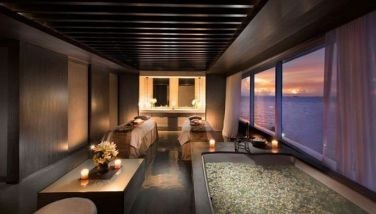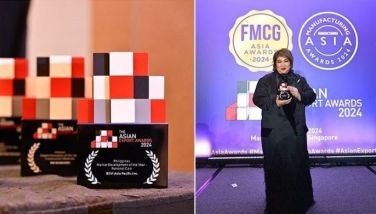Galera gimmick
March 18, 2006 | 12:00am
 Im getting old. Time was when a "gimmick" meant some scam that promised more than what was advertised. Today, it means a nightout, a party, a trip or just about anything meant to celebrate a promotion, provide a respite from our humdrum lives, or "wala lang" (just for the heck of it).
Im getting old. Time was when a "gimmick" meant some scam that promised more than what was advertised. Today, it means a nightout, a party, a trip or just about anything meant to celebrate a promotion, provide a respite from our humdrum lives, or "wala lang" (just for the heck of it).
This time of year, the main gimmicks are to celebrate graduations with friends moving on to high school, college or the world of work. In 1979, my "gimmick" was a weekend of beaches and beers with college buddies to celebrate our graduation from UP Diliman. The destination: Puerto Galera.
Boracay was totally unheard of then. Palawan was for prisoners doing time. Cebu was where you bought a guitar and danggit. The only exotic beach location known then was Sicogon, which was only accessible to foreign tourists, Playboy bunnies (they and Penthouse pets had pictorials there) or beauty queens (Gloria Diaz starred in Ang Pinakamagandang Hayop sa Balat ng Lupa, which was set there.)
Puerto Galera was barely on the tourist map but rumored to be paradise. It was easy and cheap enough to reach by bus and ferry, and college kids don’t need five-star transport or accommodations. So we hopped on a bus and took the four-hour ride to Batangas. On arrival at the ramshackle port, we hired a banca to take us to one of the many empty beaches nearby. We found this beautiful stretch of beach (which we discovered later fronted the extensive Locsin property) and made a deal with the banquero to supply us with a daily ration of fish, cooked meat, and nonstop San Miguel Pale Pilsen (back in the days when there was only one option for the golden brew).
Gold was supposedly the origin of the name of Mindoro, the large island (eighth largest in the archipelago) where Puerto Galera was located. There was supposed to be a "Mina de Oro," a mine with huge veins of gold, but the Spanish never seemed to have found it. The island had loads of marble though, although apparently little of this material is put to any good use save for souvenir ashtrays and material for firming up the island’s roads (or otherwise shipped off unprocessed and undervalued to ports unknown).
Okay, the origin of Mindoro’s name is probably a place called Minolo, say historians. It was a popular haven for ships in pre-Spanish times and located not far from today’s Puerto Galera town. Puerto Galera means "Port of Galleons" as the Spanish maritime and war fleets dropped anchor there. The place was and still is an excellent harbor that is protected from typhoons by mountains that surround it, along with the natural configuration of its bay and numerous coves and beaches. Puerto Galera’s Muelle Bay has, in fact, been voted in as one of the most beautiful bays in the world (by a European association that lists the best bays in the world).
Well, back to the summer of ’79 – we enjoyed three days and two nights of fun in the sand and sun. At the end of our stay, we had managed to get ourselves burned to a crisp (at least us boys did because we didn’t believe in sissy sun lotion). We had consumed about a truckload of beer and learned to snorkel despite only two sets of masks and fins to share with 10 people. We had to leave because we ran out of beer money, the beautiful white sand was trapped in places we could not clear without proper showers, and our hair was stiffening from lack of shampooing. We saw little of the rest of the port, much less the island of Mindoro. But we went home happy.
I returned 14 years later to check out the potential of sites in the Philippines for tourism. By that time I had established a design consultancy and my marketing research had pointed to the good prospects of tourism development – then based on a master plan for tourism under Secretary "Speedy" Gonzalez. I stayed at a resort named Coco Beach. It had several dozen cottages in rustic vernacular style, pools, a dive center, tennis courts, and an agreeable restaurant. The rates, however, were steep … but that was in comparison to the zero charge for accommodation earlier. My trip was cut short, however, and again I did not get to see much else except for glimpses of the already crowded Sabang beach (like Kuta beach in Bali). The ferry was a bit more comfortable, but the port then was still a dump.
Much has changed today. I managed to visit Puerto Galera just last month. The Batangas port is now a modern affair (though signs leading to the port from the city are non-existent). Air-conditioned lounges, more vessels, and regular runs get tourists and islanders across the 14-kilometer distance fast. The trip to Batangas from Manila has also been cut to about two hours.
The tourist experience is now more comfortable although unregulated growth has turned many of its beaches to borderline Boracay blight. Sabang, Suqui, Banilad, Bongol, La Laguna, Small La Laguna, Melco, Punta Guarda, Talipanan, and White Sand, draw a growing number of tourists – local and foreign.
The list of things to do, and places to visit has expanded from just the beaches to the hills and mountains. Mt. Halcon, at 8,488 feet above sea level, is the country’s third highest mountain. It is two hours away by jeepney or accessible through the rugged Mt. Iglit-Baco National Park (where, if you’re lucky, you’ll get a peek at the endangered tamaraw, the endangered wild buffalo of the Philippines). If you don’t see a tamaraw you can try to catch a glimpse of the Philippine deer, the Philippine warty pig, the hairy-tailed cloud rat, the Mindoro shrew, or the golden-capped fruit bat. If you’re still unlucky, you can make do with the beautiful Tamaraw falls – all 462 feet of it.
Down by the beach ,the underwater sea life is still wonderfully abundant with corals and fish in a stunning variety seen in over 30 dive sites for all levels of diving – from beginners to tech divers (too bad I gave up on the sport 10 years ago … but the crystal clear waters were sure inviting).
I was not able to climb the mountain but managed to reach the top of a nearby peak and visit the amazing Ponderosa Golf Club. Some nutty developer managed to build a 9-hole golf course 400 meters above sea level! The holes may be short and treacherous, but the views of Puerto Galera below are astounding.
A number of interesting houses designed by cutting-edge tropical modern architects like Noel Saratan and Popi Laudico now dot the mountainsides and the edges of the more exclusive beaches to take advantage of the views and the seclusion. It’s just sad that no control is exerted in other areas. Concrete and glass monstrosities, more appropriate for Binondo rather than the beach, are being built with abandon. I stayed on White Beach, where cottages are cheek by jowl. Beer and karaoke joints, along with restaurants and tattoo parlors, fill every inch of space. No sewage treatment plant, fire lanes, or proper building setbacks were evident.
Culture is in evidence though with a small museum near the parish church filled with archeological artifacts from the several digs that point to the area’s long history of trading with other Asian lands. Local cultural events are highlighted with the annual Banana Festival – in celebration of, what else but, bananas. This is held every March 18-19 (also the town fiesta of St. Joseph at Baco nearby). Celebrations feature a banana cookfest and a saba-inspired street dancing competition and beauty pageant. Visits to Mangyan villages can also be arranged and handicraft from them available. Still, one worries about the influence of tourism on local and indigenous communities there.
The purpose of my trip was to source supposedly translucent marble that could be shaped into sculpture and lit from inside. We found the marble, but the craftsmen lacked large enough blocks from which to fashion the pieces I intended. Much of their talent, too, is wasted on items from this wonderful material because of bland designs and the lack of equipment, packaging, and marketing. (Calling the Design Center!)
What the whole place really needs is a grand design, a rational master plan (and, of course, the necessary political will) that takes advantage of its resources to bring the benefits of tourism without the drawbacks of unbridled development. The environmental and social impacts of ad hoc opportunistic development so far are potentially disastrous, but the potential to learn from Boracay’s mistakes gives Puerto Galera and its lovely Muelle Bay the chance to serve as a template for sustainable tourism and a source of gimmick vacations for decades to come.
BrandSpace Articles
<
>



















